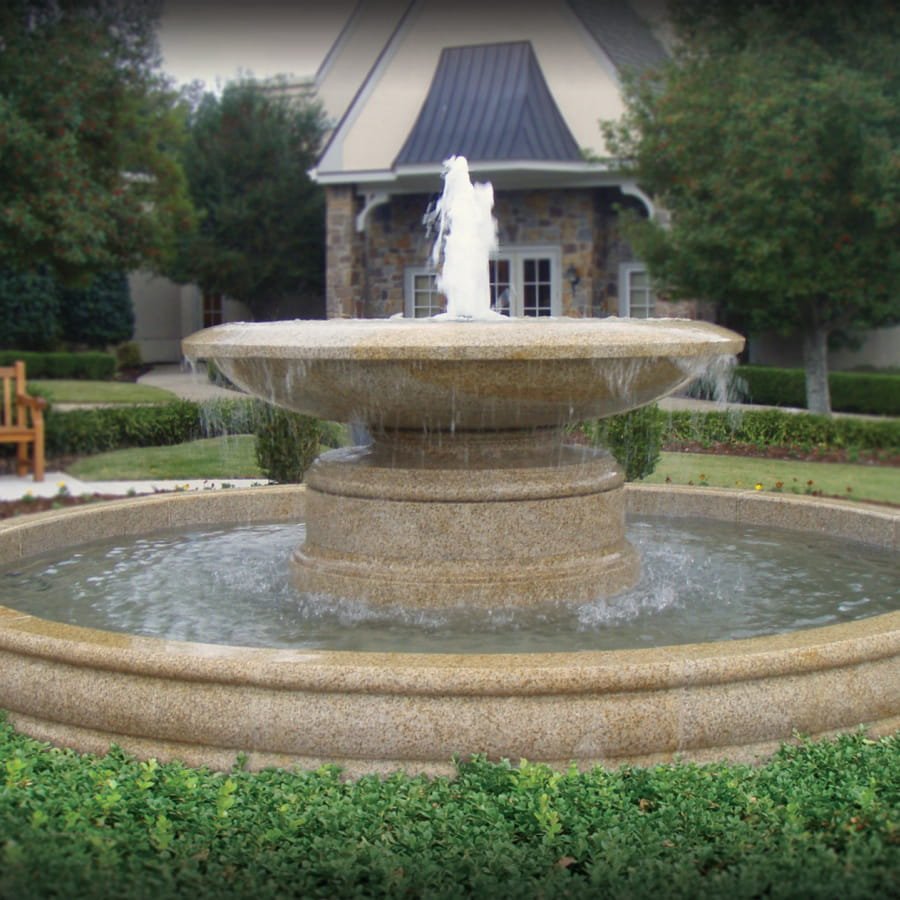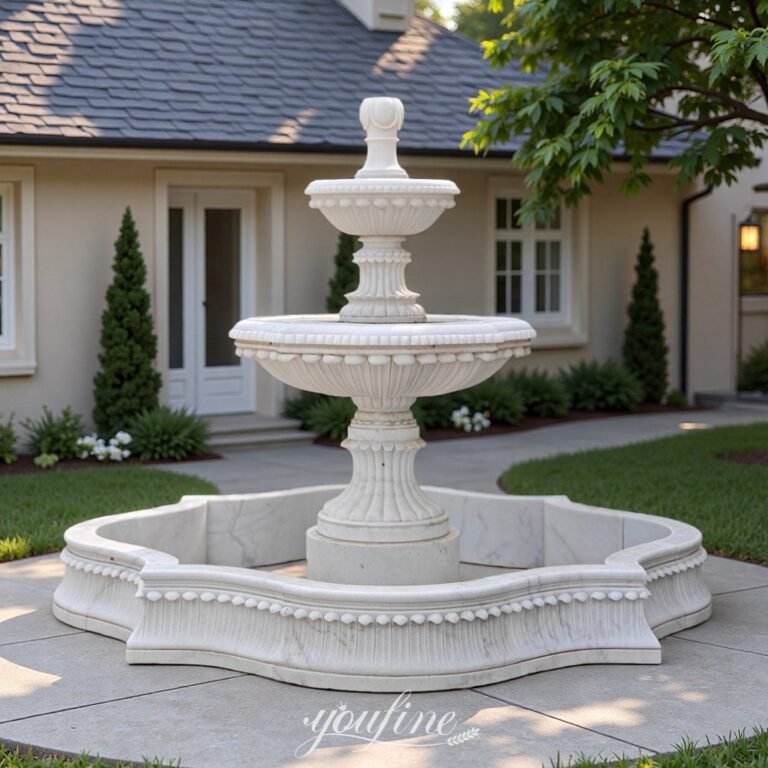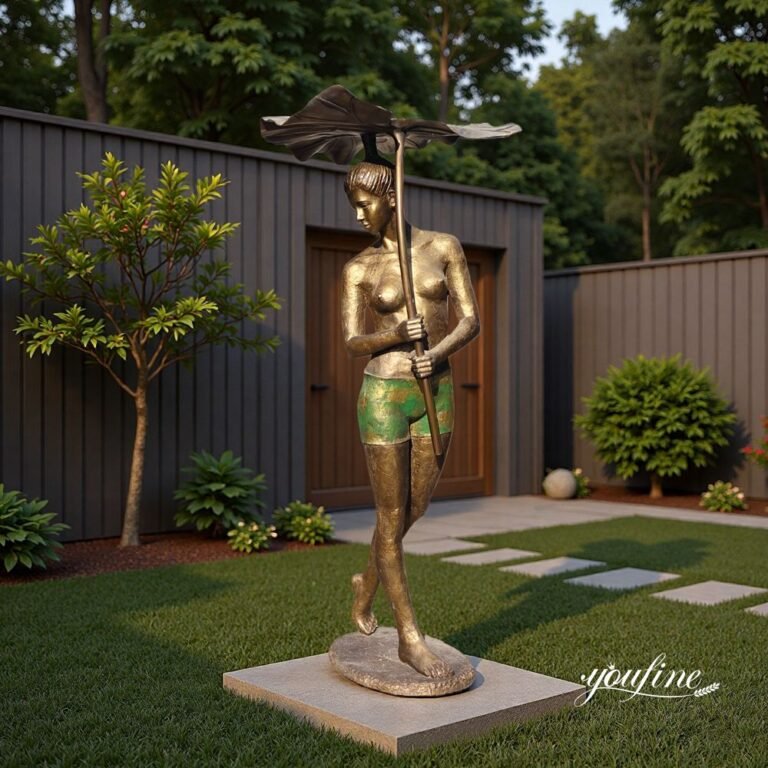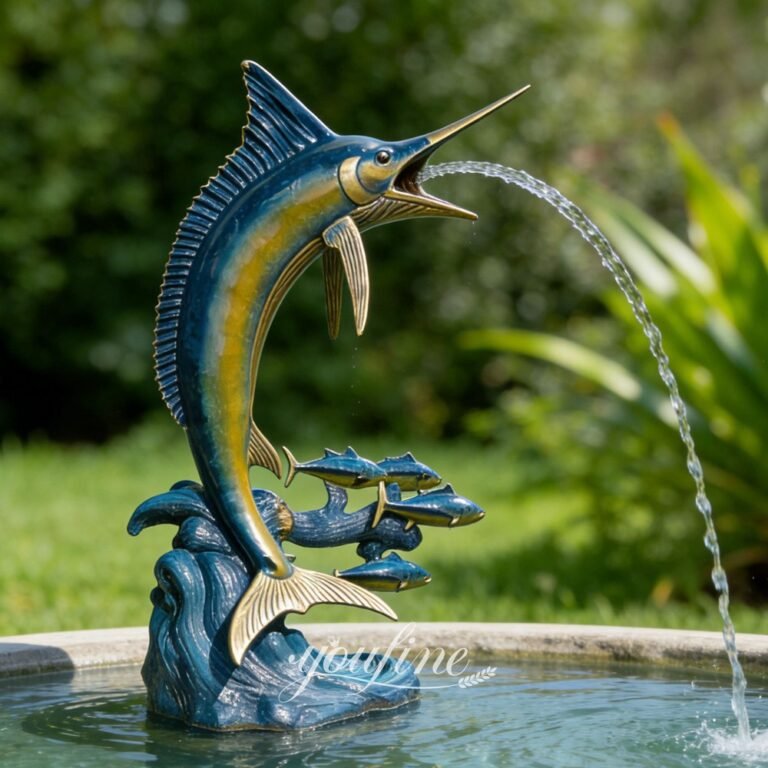Marble:
marble is a popular choice for its beauty, Its natural patterns and colors add a sophisticated touch to any outdoor or indoor space. The aesthetic qualities of marble can elevate the visual appeal of gardens, courtyards, and public spaces. Marble is also a durable natural stone that can withstand various weather conditions, including extreme heat and cold. This durability makes marble fountains a long-lasting investment. Historical examples of marble structures, such as those from Greek and Roman times, still stand today, showcasing marble’s longevity.

Source: Marble Statuary Fountain
Marble fountains can enhance the environment by increasing the content of negative ions in the air, purifying the air, increasing humidity, and lowering the ambient temperature. These benefits contribute to creating a more pleasant and healthier outdoor space.
Marble has been used in art and architecture for centuries, adding a layer of cultural and historical significance to marble fountains. This heritage often appeals to those looking to add a classic or traditional element to their landscape design
Limestone & Sandstone:
Limestone has a subtle, elegant appearance with a range of natural colors, typically in soft, earthy tones. Its fine grain and uniform texture can create a smooth and sophisticated look. Limestone is durable and can withstand various weather conditions. However, it is more porous than marble, which means it might require more maintenance to prevent water absorption and potential damage from freeze-thaw cycles.

Granite:
Granite is considered the best stone for outdoor fountains in Very cold area, due to its exceptional durability and non-porous nature. Unlike other natural stones like limestone, travertine, and sandstone, granite does not absorb water, preventing cracking and crumbling from freeze-thaw cycles. Granite is also easy to clean and maintain, ensuring your fountain stays pristine for decades.

Source: Hand carved Granite fountains
Cast stone:
a concrete-like material designed to mimic natural stone, is a common and cost-effective option for residential fountains. However, cast stone is less durable than natural stone and can deteriorate quickly, often within just 1-3 seasons, as water seeps into its porous surface and causes cracking.
For outdoor fountains, marble and granite is the superior choice due to its unmatched durability, resistance to weathering, and low maintenance requirements, ensuring your fountain remains a beautiful and long-lasting addition to your landscape.
What are italian fountains made of ?
Italian fountains are typically made from a variety of materials, including marble, limestone, travertine, and bronze. Marble is especially favored for its elegance and durability, often used in classical and Renaissance fountains. Limestone and travertine are also popular for their natural beauty and workability, while bronze is used for intricate sculptures and decorative elements, adding a timeless and artistic touch to the fountains.
What is the best fountain in the world?
One of the best and most renowned fountains in the world is the Trevi Fountain (Fontana di Trevi) in Rome, Italy. This Baroque masterpiece, designed by Nicola Salvi and completed by Giuseppe Pannini in 1762, is famous for its grandeur, intricate sculptures, and stunning design. The fountain features the central figure of Neptune, the god of the sea, flanked by Tritons and sea horses, set against a magnificent backdrop of the Palazzo Poli.

Source: large marble trevi fountain
The Trevi Fountain is not only an iconic symbol of Rome but also a major tourist attraction, drawing millions of visitors each year who follow the tradition of tossing coins into the fountain to ensure a return to the Eternal City.
What is the famous fountain in Italy?
The most famous fountain in Italy is the Trevi Fountain (Fontana di Trevi) located in Rome
- It is a late Baroque-style fountain completed in 1762, standing nearly 86 feet high and 65 feet wide.
- The fountain features an impressive marble sculpture depicting the sea god Neptune riding a shell-shaped chariot led by two seahorses, representing the moods of the sea.
- It is situated at the intersection of three roads (tre vie), which gives the fountain its name Trevi, meaning “three roads” in Italian.
- The fountain is fed by one of the ancient Roman aqueducts, the Acqua Vergine, which has provided water to the fountain since its construction.
- A popular tradition is to throw a coin over your shoulder and into the fountain, which is said to ensure a return to Rome. An estimated €1.4 million is thrown into the fountain annually.
- The Trevi Fountain has been featured in numerous films, including the iconic Fellini film La Dolce Vita, cementing its status as one of the most famous fountains in the world.
Why does Italy have so many fountains?

Italy has an abundance of fountains for several historical and cultural reasons:
Ancient Roman Aqueduct System
The vast network of aqueducts built by the ancient Romans allowed for the construction of numerous public fountains throughout the Italian cities and towns they established. These aqueducts supplied fresh water for drinking, bathing, and decorative fountains, improving public sanitation and serving as an enduring symbol of Roman engineering prowess.Many of these ancient aqueducts, like the Acqua Vergine that feeds the iconic Trevi Fountain in Rome, are still functioning today, supplying water to Italy’s famous fountains.
Artistic and Architectural Expression
Italian fountains are not just functional water sources but masterpieces of art and architecture. From the Baroque grandeur of the Trevi Fountain to the Renaissance-era Villa d’Este’s 51 ornate fountains and nymphaea, these monuments showcase the nation’s rich artistic legacy and cultural importance of water features.The design and construction of fountains provided opportunities for renowned artists and architects to express their creativity and leave a lasting imprint on Italy’s cities.
Civic Pride and Public Spaces
Fountains served as central gathering places and symbols of civic pride in Italian towns and cities. Prominent fountains like the Fountain of Neptune in Bologna were erected using public funds to beautify squares and provide water for the populace. These public spaces fostered a sense of community and became beloved landmarks.
Influence of the Catholic Church
The Catholic Church, with the papacy based in Rome, played a significant role in commissioning and funding the construction of many iconic fountains across Italy. Popes like Clement XII organized contests to build grand fountains like the Trevi Fountain as displays of power, wealth, and artistic patronage.With their ancient origins, artistic mastery, civic importance, and religious influences, fountains have become an indelible part of Italy’s cultural fabric, dotting piazzas and streets as stunning monuments that continue to inspire awe in visitors from around the world.
Why is marble used for fountains?
Marble is a popular material choice for fountains due to its beauty, durability, and historical significance:
- Beauty – Marble has a classic, elegant appearance with unique veining patterns that give each fountain a distinctive look. The different colors of marble like white Carrara, red Verona, and green Verde Antique allow for artistic expression.
- Durability – While not as durable as granite, marble is still a relatively hard and dense stone that can withstand outdoor elements reasonably well, especially if it has fewer veins. Its low porosity helps prevent water absorption and cracking from freeze-thaw cycles.
- Historical Tradition – Marble has been used for fountains and sculptures since ancient times by civilizations like the Greeks, Romans, and Renaissance Italians. Many iconic fountains like the Trevi Fountain in Rome are made of marble, continuing this long artistic tradition.
- Carvability – The relative softness of marble compared to granite makes it easier to intricately carve decorative designs, figurative sculptures, and architectural embellishments into fountain pieces.
While marble requires some maintenance and can be susceptible to damage from harsh freezing if it has many veins, its timeless beauty, historical pedigree, and ability to be ornately carved make it a premium material for creating visually stunning and culturally significant fountains across the world.
These qualities make marble a preferred material for fountains, offering both aesthetic and practical advantages.


